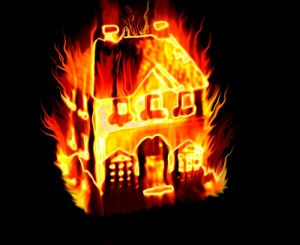It is axiomatic that the appraisers’ task is solely to determine the amount of loss, as opposed to coverage or liability. In Li-Lin Sung v. California Capital Ins. Co., 2015 WL 3797827, 2015 Cal. App. LEXIS 530 (Jun. 18, 2015), a unanimous panel of California’s Court of Appeal recently held that that necessarily entailed assessing whether components of the policyholder’s claim were actually damaged or even in existence at the time of the loss. According to the opinion, it was error to compel the appraisers to assign loss values to each and every item the insured claimed — such as damage to non-existent windows or to a fourth story on a three-story building — because assessing the existence and nature of any damage is an integral part of the appraisers’ job.
 The policyholder owned an apartment building in Oakland that was damaged by fire in November of 2010. The blaze was confined to one unit, and the insurer valued the loss at approximately $180,000. The insured contended that there was extensive fire and smoke damage to five other apartments, however, requiring that all six units be completely gutted and rebuilt and that the building’s exterior be renovated and repainted. Her claim exceeded $800,000.
The policyholder owned an apartment building in Oakland that was damaged by fire in November of 2010. The blaze was confined to one unit, and the insurer valued the loss at approximately $180,000. The insured contended that there was extensive fire and smoke damage to five other apartments, however, requiring that all six units be completely gutted and rebuilt and that the building’s exterior be renovated and repainted. Her claim exceeded $800,000.
The policyholder petitioned the court to compel appraisal, and the judge granted the petition and directed the appraisers to prepare separate valuations for: (1) all of the items of loss claimed to have been damaged by the insured; and (2) all of the items of loss admitted to have been damaged by the carrier. The panel’s award had replacement cost valuations of $813,884.89 and $190,505.21 respectively. Read more ›

 In
In  The insured owned a home in Lake City that was heavily damaged by fire on February 27, 2013. It was undisputed that the dwelling was vacant at the time of the blaze and that the fire was caused by arson. The insurer denied liability and filed a declaratory judgment action, seeking an adjudication that the loss was excluded. After cross-motions for summary judgment were filed, the trial court held that the contract of insurance was ambiguous and construed it in favor of coverage.
The insured owned a home in Lake City that was heavily damaged by fire on February 27, 2013. It was undisputed that the dwelling was vacant at the time of the blaze and that the fire was caused by arson. The insurer denied liability and filed a declaratory judgment action, seeking an adjudication that the loss was excluded. After cross-motions for summary judgment were filed, the trial court held that the contract of insurance was ambiguous and construed it in favor of coverage. Advance Cable had a building in Middleton, Wisconsin that sustained hail damage on April 3, 2011. The insurer’s claim representative inspected the roof and observed no damage. Six months later, the policyholder was contemplating a sale, and the buyer had the structure looked at. Its inspector stated that there was “definitely hail damage,” and the insured asked the carrier to reopen its claim. The resulting report by the insurer’s representative found hail dents up to 1” in diameter but concluded that these neither “affect[ed] the performance of the [roof] panels” nor “detract[ed] from the panels’ life expectancy.” There was no evidence of record to the contrary.
Advance Cable had a building in Middleton, Wisconsin that sustained hail damage on April 3, 2011. The insurer’s claim representative inspected the roof and observed no damage. Six months later, the policyholder was contemplating a sale, and the buyer had the structure looked at. Its inspector stated that there was “definitely hail damage,” and the insured asked the carrier to reopen its claim. The resulting report by the insurer’s representative found hail dents up to 1” in diameter but concluded that these neither “affect[ed] the performance of the [roof] panels” nor “detract[ed] from the panels’ life expectancy.” There was no evidence of record to the contrary.  The policyholder was a developer that was converting an office building in Tribeca in lower Manhattan into luxury condominiums when Superstorm Sandy flooded the premises in October of 2012. The storm caused more than $20 million in property damage and delay in completion loss. The insured had a builder’s risk policy with a $115 million overall limit of liability, but there was a $7 million sub-limit for delay in completion and a $5 million sub-limit for “all losses or damages arising during a continuous condition as defined in the definition of FLOOD.”
The policyholder was a developer that was converting an office building in Tribeca in lower Manhattan into luxury condominiums when Superstorm Sandy flooded the premises in October of 2012. The storm caused more than $20 million in property damage and delay in completion loss. The insured had a builder’s risk policy with a $115 million overall limit of liability, but there was a $7 million sub-limit for delay in completion and a $5 million sub-limit for “all losses or damages arising during a continuous condition as defined in the definition of FLOOD.” Last Thursday in
Last Thursday in  At the present time, Oklahoma is at the “sharp end of the spear” with respect to this issue because the state experienced fully 567 quakes of Magnitude 3.0 or greater in 2014. That is the more than in the proceeding 30 years combined, and Oklahoma is on track to see fully 1100 such earthquakes n 2015! When he released his bulletin in March, the state’s Insurance Commissioner stated that his office would assume that the state’s quakes were not man-made “[u]ntil a legal ruling is made.” It now appears that just such a ruling may well be coming in the Sooner State.
At the present time, Oklahoma is at the “sharp end of the spear” with respect to this issue because the state experienced fully 567 quakes of Magnitude 3.0 or greater in 2014. That is the more than in the proceeding 30 years combined, and Oklahoma is on track to see fully 1100 such earthquakes n 2015! When he released his bulletin in March, the state’s Insurance Commissioner stated that his office would assume that the state’s quakes were not man-made “[u]ntil a legal ruling is made.” It now appears that just such a ruling may well be coming in the Sooner State. The policyholder owned a home in St. Charles that sustained siding damage in a hailstorm in April 2012. The damage was confined to the home’s northern side, and the carrier paid the actual cash value for replacement of all of the siding on that portion of the building. Because the original siding was no longer manufactured, however, the insured contended that she was entitled to recover for replacing the siding on the entire structure, and she brought suit after the insurer refused.
The policyholder owned a home in St. Charles that sustained siding damage in a hailstorm in April 2012. The damage was confined to the home’s northern side, and the carrier paid the actual cash value for replacement of all of the siding on that portion of the building. Because the original siding was no longer manufactured, however, the insured contended that she was entitled to recover for replacing the siding on the entire structure, and she brought suit after the insurer refused.  The policyholder operated a welding business in Uniondale, and the company stored scrap metal in an ungated yard on the property. As summarized by the court, the undisputed facts were as follows:
The policyholder operated a welding business in Uniondale, and the company stored scrap metal in an ungated yard on the property. As summarized by the court, the undisputed facts were as follows: Washington State has long been a jurisdiction with no judicial pronouncement as to the meaning of the term “collapse” in a property insurance policy, but that changed last Thursday when the state’s Supreme Court issued its decision in
Washington State has long been a jurisdiction with no judicial pronouncement as to the meaning of the term “collapse” in a property insurance policy, but that changed last Thursday when the state’s Supreme Court issued its decision in 